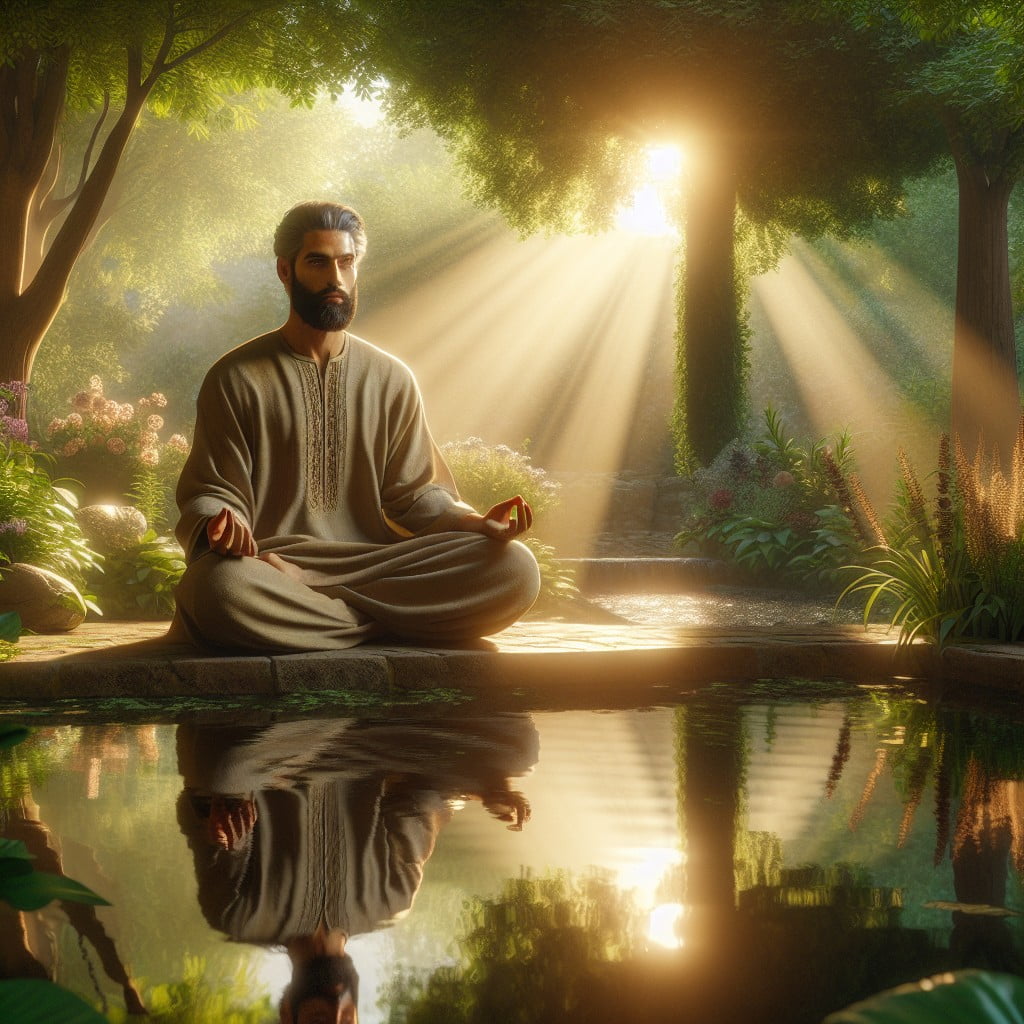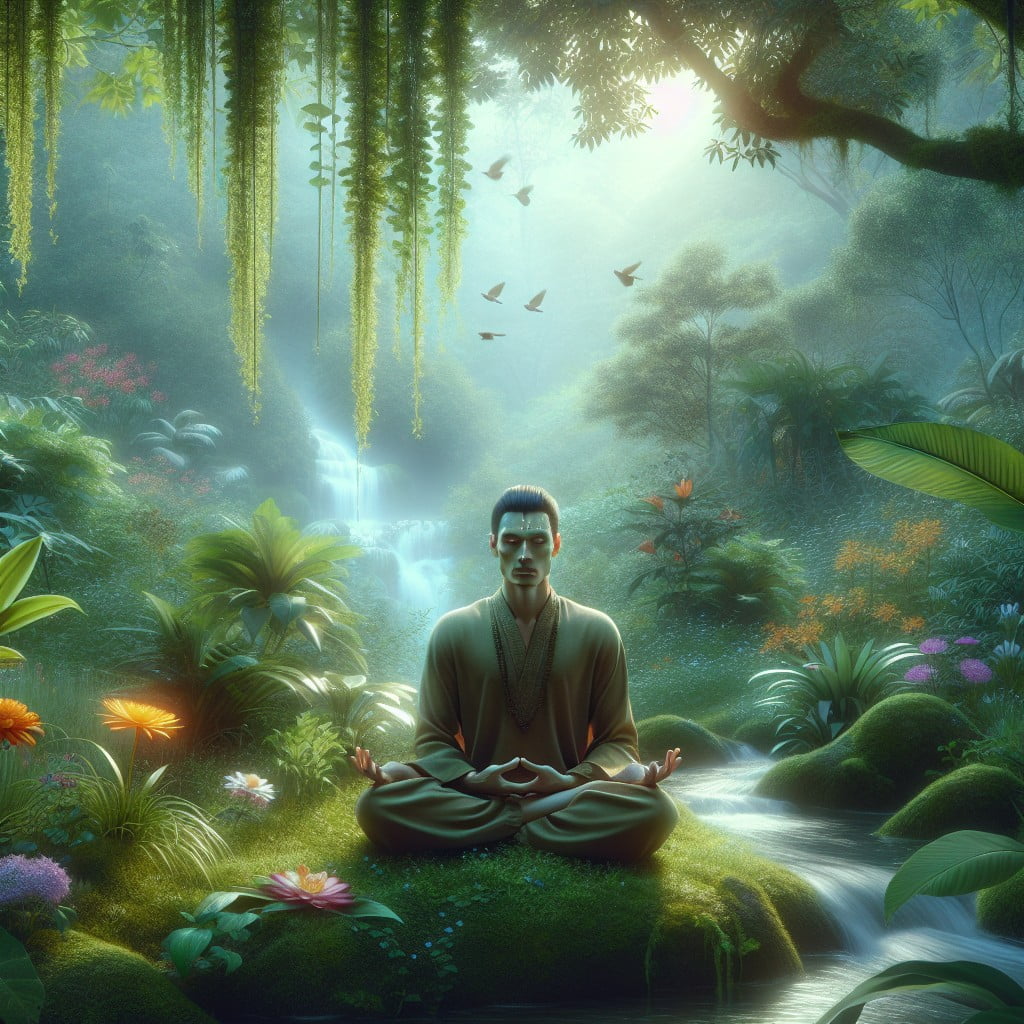Exploring open-eyed meditation reveals an enlightening truth because closing your eyes isn’t always necessary for transformative mindfulness practices.
Key takeaways:
- Open-eyed meditation is a valid and effective technique.
- Traditional meditation practices can be adapted to include open eyes.
- Key points for open-eyed meditation include choosing a gentle point of focus and using peripheral vision.
- Open-eyed meditation enhances focus, stability, and presence.
- Visualizing with open eyes can enhance the meditative experience.
What Is Meditation?

Meditation is a practice rooted in ancient traditions, now widely embraced for its mental health benefits. It involves techniques to focus the mind, foster a sense of calm, and promote mental clarity and emotional stability.
Core elements typically include:
- Concentration: Selecting a single point of focus, such as the breath, a mantra, or a visual object, to train attention.
- Mindfulness: Paying deliberate, nonjudgmental attention to the present moment, noticing sensations, thoughts, and emotions as they arise.
- Breathwork: Using breathing patterns to anchor the mind and regulate the body’s relaxation response.
- Posture: Sitting, standing, or lying in a position that is stable yet comfortable, facilitating sustained practice.
- Consistency: Meditating regularly to cultivate a deeper practice and integrate mindfulness into daily life.
While traditionally performed with closed eyes to minimize distractions and deepen inward focus, meditation can flexibly adapt to individual preferences and circumstances, embracing various postures and states of eye closure.
So, Can You Meditate With Your Eyes Open?

Certainly, traditional meditation doesn’t mandate the closing of eyes. On the contrary, several practices encourage maintaining a soft gaze to keep the connection with the immediate environment. This can enhance alertness and present moment awareness.
Tibetan Buddhism, for example, includes techniques like Trataka, where one focuses gently on an external object. Zen practices often involve a downward gaze, avoiding eye strain and assisting in grounding and stabilizing attention.
The intent behind open-eyed meditation isn’t simply to avoid closing eyes but to integrate the meditative state into everyday life. Here, the line between meditation and daily activities begins to blur, enabling individuals to cultivate mindfulness continuously.
Key points to consider:
- Choose a gentle point of focus; it could be a spot on the floor or a natural element.
- A relaxed gaze helps prevent visual distractions from disrupting your mental flow.
- Combine this practice with regulated breathing for added steadiness and concentration.
- Use peripheral vision to acknowledge your surroundings without shifting focus.
- Open eyes can help in situations when drowsiness is a barrier during meditation.
By integrating open-eyed methods, you foster a bridge between the tranquility of meditation and the dynamism of life, encouraging a seamless transition of mindfulness into your daily interactions.
How to Meditate With Open Eyes
Begin by finding a quiet space where you can sit comfortably without distractions. Choose a low-lit area to help maintain focus and reduce eye strain.
Select a fixed point in front of you, preferably at a downward angle to avoid eye fatigue. This can be a spot on the wall, a pebble, or a simple object.
Soften your gaze, allowing your eyes to relax fully, not staring intensely but rather noticing your chosen point with ease.
As you settle into this practice, be mindful of your breathing. Inhale and exhale slowly, deeply, and with intention, aligning your focus with your breath.
If your attention wanders, gently acknowledge the distraction and bring your gaze back to the chosen point, maintaining awareness of your breath.
Incorporate visual elements of your surroundings into your practice—acknowledge the play of light, shadows, and shapes without attaching to them. Feel them blending into your state of calm.
Limit the duration of your first few sessions to just a few minutes, gradually increasing the time as your comfort with the practice grows.
Benefits of Open-eyed Meditation
Open-eyed meditation offers distinct advantages conducive to modern living.
- Enhanced Focus: Practicing in a state of alertness can heighten concentration, turning mundane daily visuals into anchors for mindfulness.
- Seamless Transition: Eye-open techniques help integrate meditative awareness into everyday activities, blurring lines between practice and life.
- Stability in Distractions: Reduces reliance on perfect conditions for meditation, fostering resilience in the face of external stimuli.
- Improved Posture: Visual points of reference can encourage a straight spine, aiding in the reduction of physical strain.
- Increased Presence: By merging meditation with visual experience, practitioners often find it easier to stay present moment-to-moment.
What Happens When You Meditate With Your Eyes Open?
Transforming your focus from the internal to the external, meditating with your eyes open encourages a deeper connection with your surroundings. Attention softens, enabling a gentle awareness of the environment without fixating on specific details, which can lead to a sense of being present and grounded.
Additionally, this practice often helps meditators integrate mindfulness into daily activities, providing the ability to maintain calm and awareness during moments of activity or interaction. Engaging in open-eyed meditation may also reduce the likelihood of drowsiness, which some individuals experience when meditating with eyes closed. The combination of a soft gaze and a directed inward focus creates a balanced state that encourages both alertness and relaxation.
How Do You Visualize With Your Eyes Open?
Visualizing with open eyes is a skill that enhances focus and presence in the moment. To begin this practice, choose a static object or spot in front of you to gaze at softly. Ensure your gaze is relaxed, not staring intensely, to avoid eye strain. With this gentle visual anchor, start picturing a scene or image in your mind. It could be a peaceful beach, a mountain, or a simple geometric shape.
Allow this mental image to become as vivid as possible, engaging all your senses in the process. Imagine the sounds in this scene, the scents, and the tactile sensations. For example, if it’s a beach, hear the waves, smell the ocean, and feel the warmth of the sun. This multi-sensory approach anchors the visualization and makes the experience more profound.
As thoughts or external distractions surface, acknowledge them and let them pass, returning your focus to your chosen image. With regular practice, this technique enriches your open-eyed meditations, merging your inner and outer experiences seamlessly.
Try Meditating With Your Eyes Open
Approaching open-eyed meditation can be a refreshing experience. It’s best to start gradually if you’re accustomed to meditating with closed eyes. Here are a few steps to ease into the practice:
- Choose a soft gaze: Select a spot on the floor or wall a few feet ahead. Let your gaze be soft and unfocused, avoiding intense staring which can cause eye strain.
- Limit distractions: A tranquil environment can help maintain focus. Remove clutter from your line of sight if possible.
- Incorporate your surroundings: Allow the shapes and colors around you to blend into the background of your awareness, integrating with your meditative focus rather than competing for attention.
- Mindful blinking: Blink naturally. Become aware of the rhythm of your blinking and let it assist in grounding you in the present moment.
- Adjust as needed: If you find your attention wavering or discomfort arising, gently close your eyes for a few moments. Reopen them as you feel ready, without judgment.
Implementing these points gently introduces the practice of open-eyed meditation, enhancing mindfulness and presence.
Your Partner Disapproves?
If your partner is skeptical about meditation or prefers that you keep your eyes closed, communication is key. Discuss with them the reasons you choose to meditate with your eyes open, perhaps highlighting the sense of presence and awareness it brings to your practice. Offer insights into how this method helps you engage more fully with the moment, and how it could potentially benefit your relationship, such as fostering greater patience and empathy.
Invite them to try it with you or observe a session to understand better. Respecting each other’s preferences and finding a compromise, like alternating between open and closed-eye sessions, can also maintain harmony. Remember, the essence of meditation lies in the comfort and connection it brings to your inner self, regardless of external approval.
Other Ways to Practice?
In addition to traditional seated meditation, there are numerous mindfulness practices that integrate into daily life:
1. Walking Meditation:
Walk slowly and focus on the sensation of your feet touching the ground, aligning each step with your breath.
2. Mindful Eating:
Eat slowly, savoring each bite, appreciating the flavors, textures, and smells.
3. Body Scan:
Lie down and mentally scan your body from head to toe, observing sensations without judgment.
4. Mindfulness Bell:
Set a bell or app to ring at intervals as a reminder to pause, breathe, and bring attention to the present moment.
5. Yoga:
Perform yoga poses with intentional breathwork to foster a meditative state through movement.
6. Daily Tasks Mindfulness:
Engage fully with regular activities like washing dishes or showering, noticing all aspects of the experience.
By incorporating mindfulness into everyday scenarios, one cultivates a habit of being present, transforming ordinary moments into opportunities for meditation.
Too Busy to Meditate?
Incorporating moments of mindfulness into daily activities can serve as a substitute for those with time constraints. During tasks like washing dishes, taking a shower, or even during short breaks at work, practicing deep, intentional breaths and cultivating present moment awareness can turn ordinary actions into meditative experiences.
Scheduling brief, consistent meditation intervals, as little as five minutes, can also create lasting habits without overwhelming a busy schedule.
Use waiting periods, such as a traffic light stop or standing in line, to focus on your breathing and center yourself, transforming these typically idle moments into opportunities for calm and clarity. Utilizing guided meditation apps during commutes on public transportation can be another efficient way to integrate practice into a hectic routine.
Remember, consistency matters more than duration; even small, habitual doses of meditation are beneficial. Recognizing that meditation can adapt to fit into available gaps throughout the day demystifies the assumption that it requires a significant time investment.
FAQ
Is it okay to meditate with eyes open?
Yes, it is perfectly okay to meditate with your eyes open, as the preference for open or closed eyes during meditation largely depends on the individual's comfort and ease in minimizing distractions.
How do I know if I'm actually meditating?
You'll know you're meditating if you can maintain focused attention on an anchor point such as your breath, body sensation, or a mantra, even if it's challenging at first.
Do Buddhists meditate with eyes open or closed?
In various schools of Buddhism, practitioners choose to meditate either with their eyes open, often looking downward with a shortened gaze, or with them closed, depending on the type of meditation being performed.
Is it OK to lay down while meditating?
Yes, it is perfectly acceptable to lay down while meditating as it can lead to more efficient spinal alignment and potentially more extended periods of meditation.
What is the significance of gaze in different meditation practices?
The significance of gaze in different meditation practices is that it helps concentrate the mind, with different traditions employing various focal points such as the tip of the nose in zen practice, or the space in front of you in Dzogchen.
Can focusing on a visual object during meditation enhance the experience?
Yes, focusing on a visual object during meditation can indeed augment the meditative experience by promoting focus and mindfulness.
Are there specific meditations designed for open-eyed practice?
Yes, certain types of meditations, such as Trataka (gazing) and Zen meditation, are specifically designed for open-eyed practice.